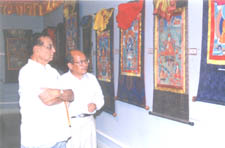Sakyamuni – Brilliance, Out Of Context

Sakyamuni – Brilliance, Out Of Context is an event that took place between 25-Feb-2001 and 07-Mar-2001 in Hyderabad.
-
Venue
-
Date/Time
-
Type
-
Price
-
Tickets At
-
Add New Field:
In every society art has a special context. The refined/urbane society perceives art as something to do with aesthetics, value and antiquity, something that must be enjoyed, preserved and handed down to progeny. In the folk traditions, it is a means to celebrate, to integrate society via culture. Therefore, there is always a festive element attached to it - it is like a medium of entertainment. And going a little deeper, in the tribal culture, art is a practice of faith. Every element, however decorative and aesthetic in creation and appearance, is a votive preparation.
The summary is that, when displaced from its environment, art is bound to loose its connection from its original establishment. And the thanka paintings on display in the Salar Jung Museum more or less illustrate the effect of something taken out of its context.
Sakyamuni, the exhibition of 60 rare thankas of Buddhist art curetted and organized by the Central Institute of Buddhist Studies, Leh (Ladakh), and compiled from 4 major gonpas (Buddhist viharas / monastic settlements), offers us an insight into the ideas behind the practice of this art form. The various exhibits here are brought to us from a historical and aesthetical viewpoint. The show is a vignette of the Buddhist cultural heritage, which has been destroyed in its own region but preserved in other parts of the world. Portraying the various 'avatars' of Lord Buddha and the Bodhisattvas, the thankas have a definite and defined way of practicing this art for religious purposes.
If we look at the fundamentals and the significance of the thanka practice, we get to know that Silpa (art and craft) is a special branch of knowledge that facilitates the attainment of the'Absolute Truth' (the others including Sabda (grammar), Tarka (logic and epistemology) and Chikitsa (medical science), the Mahavidyas). Therefore, the thankas are not just grand lengths of skillfully designed colorful scroll paintings from the enigmatic land of the Himalayas, but are a ritualistic art that take the young Buddhist disciple a step closer towards his goal of attaining 'gayana'.
In contrast to the individualistic and expressionistic mode of contemporary art being a mental vehicle of venting out the buildups of the subconscious mind, this form is a highly cultivated device of symbolism. Every element incorporated on the scroll contains a significant meaning. Right from the way that the canvas is prepared and the background is visualized to the depiction of the central figure and the stitching of the yellow, red and blue silk borders, everything leads to the ultimate evocation and infusion of special deities. Esoteric in content, the Thanka art is viewed as a record of mystic vision attained by saints/Lamas during the deep meditation.
For instance, Thanka 2, Arya Manjusri, of the Sman-Bris School of Art, part of the 20th century collection of the Central Institute of Buddhist Studies, Choglamsar, Leh, is a rich piece depicting the variegated forms of Manjusri, the incarnation of wisdom. The central Manjusri holds, in the right hand, the magnificent sword that destroys all ignorance and that sharpens the intellect, and the lotus in the left hand has the book of transcendental wisdom itself. This peaceful vision of Manjusri is a classic formatting that seems narrative, but if observed closely, is crisp and sharp.
These spiritual canvases are either installed in family shrines or in assembly halls of monasteries as objects of worship. As votive offerings devotees place fruits, flowers and light butter lamps before the thankas for a better life - a spiritual development that translates into love and compassion for all beings.
Therefore, Sakyamuni in Hyderabad is a partial montage of a culture that comes to us in the most brilliant form of the thankas. Hence, the sanctity of the Buddhist can be perceived by us as a heritage and generate respect for multi-cultural co-existence.
Be the first to comment on Sakyamuni – Brilliance, Out Of Context! Just use the simple form below.
LEAVE A COMMENT
fullhyd.com has 700,000+ monthly visits. Tell Hyderabad what you feel about Sakyamuni – Brilliance, Out Of Context!
MORE EVENTS IN THIS PERIOD
ALL EVENT CATEGORIES
SEARCH EVENTS
Dissatisfied with the results? Report a problem or error, or add a listing.
ADVERTISEMENT
SHOUTBOX!
{{ todo.summary }}... expand »
{{ todo.text }}
« collapse
First | Prev |
1 2 3
{{current_page-1}} {{current_page}} {{current_page+1}}
{{last_page-2}} {{last_page-1}} {{last_page}}
| Next | Last
{{todos[0].name}}
{{todos[0].text}}
ADVERTISEMENT
This page was tagged for
A P State Archaeology Museum events
February 2001 events
hyderabad arts
hyderabad paintings
hyderabad exhibitions